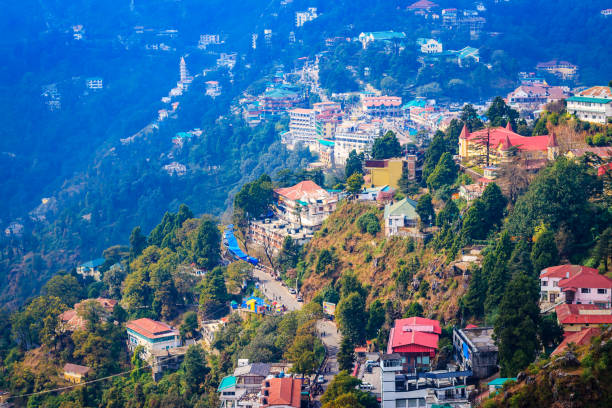1. Introduction
Brief introduction to Dehradun as the capital of Uttarakhand : A place that is delectably charmed, with the capital of Uttarakhand being Dehradun, it is a city encapsulated in the foot hills of the Himalayas. With Dehradun being a gateway to some of the most marvelous hill stations and pilgrimage centers that northern India could boast of-such as Mussoorie, Haridwar, and Rishikesh-it offers perfect blends of nature, modernity, and adventure, spirituality, and peace-all rolled into one. The city is famous for its education centers and the historical significance. Dehradun is the principal cultural and administrative center in the state of Uttarakhand.
Mention its popularity as a travel destination and its proximity to the Himalayan region : Dehradun, with its soft landscapes, an amiable weather, and adjacent to the impressive Himalayas range, is considered one of the most visited cities. As one of the easiest access points in the Himalayan region, nature lovers, adventurous souls, or spiritual wanderers all throng to this city to explore their pursuits. Being on the edge to the well-famed hill station Mussoorie and a well-known pilgrimage area Haridwar and Rishikesh city, it makes itself a base while visiting the southern foothills of the Himalayan range. It has a blend of scenic beauty, adventure activities, and cultural richness that makes it a must-visit destination for anyone looking to experience the allure of the Himalayas.
2. History and Cultural Significance
Historical background: Role during the British era and ancient roots : Dehradun, the capital city of Uttarakhand, is a place rich in history from ancient times, with considerable influences from the British era.Ancient Roots
1. Mythological Connections: Ancient Indian literature and epics such as the Mahabharata and the Ramayana refer to Dehradun.
According to legends, Guru Dronacharya, the teacher of both the Pandavas and Kauravas, resided here. That is why the city was initially called “Dronanagari.
2. Buddhist and Hindu Influences: In this region, Buddhism spread its influence during the period of Emperor Ashoka.
Temples and ruins are scattered around the area because of its long religious and cultural history.
3. The Name ‘Dehradun: Derived from the words “Dera” meaning camp and “Dun” meaning valley, the name is attributed to the settlement founded by Sikh Guru Ram Rai in the 17th century. His arrival established a dera or camp in the doon valley.
Role During the British Era
1. Strategic Location: Being close to the Himalayas and at a central location, Dehradun was an important administrative and military hub for the British.
It was a cool retreat for British officers and their families during the summer months.
2. Forest Research Institute (FRI): Founded in 1906, FRI emerged as an iconic hub for research into forestry.
The building has a very typical Greco-Roman architecture that reflects the British architectural influence.
3. Development of Infrastructure: The widespread development of roads, railways, and schools during the British period formed the crux of Dehradun’s modern growth.
Institutionalizing of The Doon School and Welham Girls’ School was made during this time, making it an educational center.
Role in the Freedom Movement: The city had a strong following for India’s freedom movement.
The freedom fighters from the region contributed to the larger movements across India, and Dehradun was a silent witness to this transformative period.
3. Top Attractions in Dehradun
Robber’s Cave (Guchhupani): Natural cave formations and streams: One of the most interesting natural attractions in Dehradun is referred to locally as Guchhupani, or Robber’s Cave. It is famous for cave formations, flowing streams, and an intriguing atmosphere.
Location and Accessibility
Distance: Situated about 8 kilometers from the city center of Dehradun.
Accessibility: The location is accessible via car or auto-rickshaw. It’s a short trek from the parking area to reach the entrance of the cave.
Formation and Features
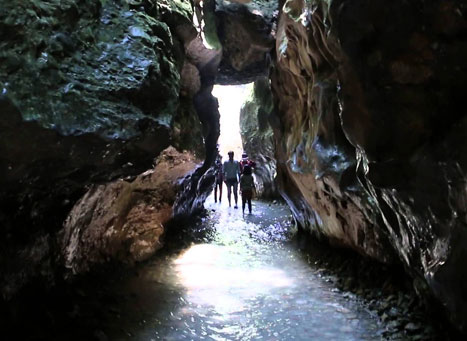
1. Natural Cave Structure: It is a narrow gorge between two big cliffs, and a river flows right throug it.
The walls of the cave are naturally sculpted, creating stunning patterns that add to its mystique.
2. Stream Inside the Cave: A shallow stream runs the entire length of the cave; visitors can walk through the cool waters.
The depth of the stream varies at different points but is generally accessible to most visitors.
Breathtaking Waterfalls: At the end, there is a small but very striking waterfall which gives a peaceful and beautiful landscape.
Sahastradhara: The Thousand-Fold Spring : Sahastradhara is a word meaning “Thousand-Fold Spring” and is, without any doubt, one of the most entrancing and prominent tourist attractions located in Dehradun. Soothing sulfur springs can be found there, as well as cascading waterfalls that make this location a perfect synthesis of natural splendor, quietness, and unique geological peculiarities.
Location and Accessibility
Distance: About 14 kilometers from city centre of Dehradun.
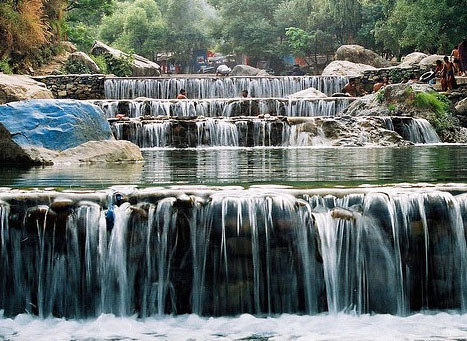
Accessibility: This is easily accessible using private vehicles, taxis, and local buses. A short walk from the parking area leads to the main attraction.
Features and Highlights
1. Sulfur Springs: Its chief attraction is a natural sulfur water spring, considered to have medicinal and therapeutic value.
The water has a rich mineral content and contains a smell from sulfur. It is believed to be good for skin diseases and joint pains.
2. Waterfalls: The waterfalls at Sahastradhara are formed as water flows over limestone stalactites, creating fascinating cascades.
The droplets shimmer in the sun, giving the place an added charm.
3. Natural Pools and Caves: The springs form shallow pools where visitors can take a dip and enjoy the refreshing water.
Small caves around the area enhance the scenic beauty and offer perfect spots for exploration and photography.
Geological Significance: The limestone formations here are evidence of centuries of natural erosion and deposition, resulting in interesting rock structures.
The springs are part of a karst topography, where water flows through soluble rocks, enriching it with minerals along the way.
Visitor Experience
1. Activities:
Bathing in the Springs: Lots of visitors soak themselves in the pools to reap the restorative effects of sulfur-rich water.
Nature walks: Take strolls around the greenery surrounding your area and feel the beauty of the hills.
Cog Railway Ride: A ropeway ride is there to take to the hill top, from which one can view the valley below.
2. Best Time to Visit:
The best time to visit is during the monsoon season, from July to September. During this period, the waterfalls are full of water and enhance the beauty of nature.
Winters are relatively quiet with cool weather, ideal for quiet, peaceful outdoor activities, from November to February.
3. Nearby Attractions:
Baldi River: A small river that adds to the beauty of the area.
Temples and Shrines: There are a few ancient temples nearby that offer spiritual solace.
Amenities and Facilities
Basic facilities like changing rooms, sitting areas, and food stalls are available.
Local restaurants serve food, drinks, and local specialities.
Sphy, where water flows through soluble rocks, enriching it with minerals along the way.
Tips for Visitors
Carry towels and extra clothing if you plan to bathe in the springs.
Nonslippery footwear should be worn in case the place surrounding the pools is slippery and wet.
Go early in the day to appreciate the serenity and avoid crowds.
Why Visit Sahastradhara?
Sahastradhara offers a unique blend of natural beauty, therapeutic experiences, and geological wonder, making it an ideal destination for families, nature enthusiasts, and those seeking relaxation. The soothing ambiance of this “thousand-fold spring” is sure to leave visitors rejuvenated and awestruck by nature’s splendor.
Mindrolling Monastery: Tibetan Buddhist monastery with striking architecture :
The Mindrolling Monastery is one of the largest Tibetan Buddhist centers in India, located in Dehradun. Known for its beautiful architecture, peaceful ambiance, and cultural significance, this monastery is a beacon of peace and enlightenment that attracts visitors from all over the world.
Location and Accessibility
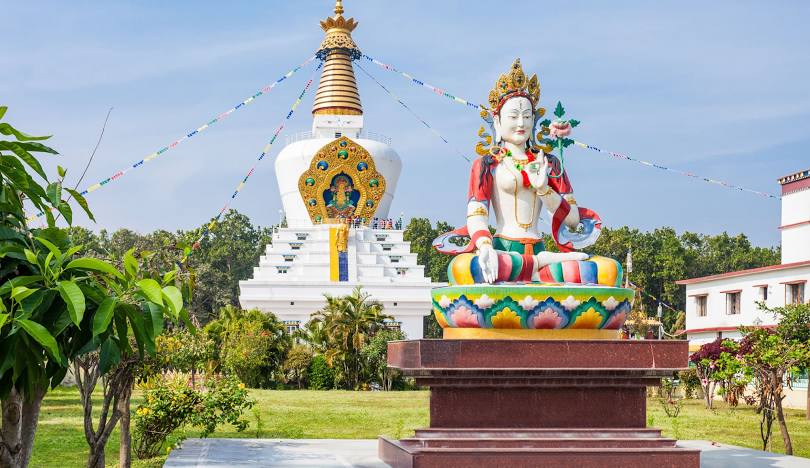
Distance: 10 km to city center of Dehradun.
Accessibility: Accessible by taxi, car, and local transport.
History and Significance
- 1. Foundation: Established by Khochhen Rinpoche and the monks in the year 1965, it belongs to Nyingma- school of Tibetan Buddhism.
- It is a replica of the original Mindrolling Monastery in Tibet, established in 1676.
2. Purpose: The monastery becomes a center of learning and practice for Buddhist scripture, Tibetan tradition, and any other arts of study.
It also has an important role in the preservation of Tibetan culture and heritage.
Architectural Highlights
- 1. Main Stupa (The Great Stupa): One of the tallest stupas in Asia, standing at 60 metres, close to 200 feet.
- The stupa is adorned with detailed murals, colorful frescoes, and statues that represent Buddhist teachings and deities.
- It symbolizes the elements of fire, water, air, earth, and space on its five floors. Each of its levels offers deep insight into the Buddhist philosophy.
2. Main Prayer Hall: A very spacious hall with wonderful murals and thangkas adorning the walls. - The golden statue of Buddha in the prayer hall is spectacular and serves as a focal point for meditation and worship.
3. Gardens and Surroundings: The monastery is surrounded by well-maintained gardens, adding to the tranquility of the space.
The fluttering, colorful prayer flags add to the spiritual ambiance in the air.
Cultural and Spiritual Activities
- 1. Teachings and Meditations: Sessions on Buddhist philosophy and meditation techniques are often conducted for practitioners and visitors alike.
- Special pujas and ceremonies are performed on auspicious days.
2. Cultural Preservation: The monastery celebrates many traditional Tibetan festivals and events, which exhibit Tibetan music, dance, and crafts.
3. Bookstore and Shops: There are shops selling books on Buddhism, meditation aids, Tibetan handicrafts, and souvenirs.
Visitor Experience
- 1. What to Do: Let’s take a stroll through the gardens and enjoy this serenity.
- Climb to the top of the stupa for an all-around view of the surrounding landscape.
- Pray in the quiet of the prayer hall, reflecting or meditating.
2. Best Time to Visit: The monastery is open throughout the year, but spring and autumn are best times for nice weather and outdoor explorations.
Visit during the Tibetan festivals of Losar (Tibetan New Year) for a very lively cultural experience.
Tips for Visitors
Dress modestly and respect the sanctity of the space.
Photography is permitted in the gardens and outer areas but may be limited inside some areas.
Allocate at least 2-3 hours to explore the monastery and its surroundings.
Why Visit Mindrolling Monastery?
Mindrolling Monastery is not a place of worship but also serves as an entry to understanding Tibetan culture, spirituality, and architectural grandeur. If you need spiritual solace, cultural insight, or even a peaceful retreat, this monastery promises to offer you a memorable and enriching experience.
Would you like information on nearby attractions or other activities to combine with your visit?
Forest Research Institute (FRI): Iconic colonial architecture and museum.
The Forest Research Institute in Dehradun is an architectural marvel and a center of excellence in forestry education and research. Located amidst lush greenery, the iconic institution is a haven for history buffs, nature enthusiasts, and architecture admirers alike.
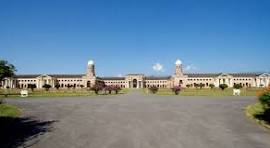
Location and Accessibility
Distance: It lies about 5 kilometers from Dehradun city center.
Accessibility: Good connectivity through road. Approachable through Taxis, autos, and buses.
History and Significance
- 1. Establishment: FRI was established in 1906, during British rule, to promote forestry research and education in India.
- It became a premier institution for forest science under the Indian Council of Forestry Research and Education (ICFRE).
2. Legacy: As one of the oldest institutions of its kind in India, FRI has made remarkable contributions to the cause of sustainable forestry practices and environmental conservation.
It continues to remain a hub of national and international forestry research.
Architectural Highlights
- 1. Colonial Grandeur: It has a Greco-Roman architectural style, which includes some elements of colonial and Indian influences.
- The building, constructed in 1929, is made of red bricks with imposing colonnades, arches, and wide courtyards.
2. Scale and Layout: The campus stretches over 450 hectares and is surrounded by dense forests and manicured lawns.
The very central building was a great landmark that had symmetrical designs and walkways stretching for miles.
3. Landmark Recognition: FRI has been featured in several Bollywood movies due to its grandeur, including the popular films Student of the Year and Rehnaa Hai Terre Dil Mein.
Museums Inside FRI
1. Pathology Museum: Concentrates on the diseases attacking plants and trees.
2. Timber Museum: Exibits different samples of woods and their uses.
3. Silviculture Museum: Explains tree cultivation and forest management practices.
4. Entomology Museum: It features insects that influence forests, be it positively or negatively.
5. Non-Wood Forest Products Museum: This focuses on products like gums, resins, and fibers from forests.
6. Social Forestry Museum: This is dedicated to the use of forests to enhance community well-being and income.
Visitor Experience
- 1. Activities: Guided museum tours about an in-depth knowledge of forestry and environmental science.
- Walks through the vast gardens and wooded trails for a tranquil experience.
- Photography, as the building and its surroundings offer wonderful backdrops.
2. Best Time to Visit: Open throughout the year, though the best weather for outdoor explorations is the post-monsoon season and winters, that is, from October to February.
3. Timings and Entry: The institute is accessible to visitors between morning and late afternoon. However, entry charges are applicable on tourists.
Educational and Recreational Importance
FRI serves as an educational source for students and researchers in the forestry, environmental science, and other related areas.
It is also an ideal place for picnics, nature walks, and other leisurely activities because of its serene environment.
Why Visit the Forest Research Institute?
The Forest Research Institute is one of the destinations that combine history, architectural magnificence, and environmental education. Whether you are interested in history, nature, or just a curious traveler, FRI offers an enriching experience that perfectly unites the past and the future of forestry and conservation.
Tapkeshwar Temple: A cave temple dedicated to Lord Shiva
Situated in the lush green hills of Garhwal, the Tapkeshwar Temple is one of the most sacred places in Dehradun. It is a unique cave temple, devoted to Lord Shiva, attracting devotees and tourists for its spiritual value as well as its natural beauty.
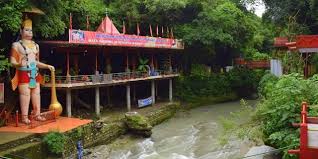
Location and Accessibility
Distance: This is approximately 6 kilometers away from the central Dehradun.
Accessibility: Accessible by road; one can reach the temple through taxis, autos, or private vehicles. The temple is downhill and within a short walking distance from the premises.
Mythological Significance
- 1. Connection to the Mahabharata: According to legends, Guru Dronacharya, who taught the Pandavas and Kauravas, meditated here. That is why the surrounding area is also known as Drona Cave.
Divine Origins of the Lingam: It is believed that the Shivling inside the temple is self-formed inside the cave. Drops of water continually trickle down from the roof of the cave on to it, and this is considered sacred because it symbolizes the blessings of Lord Shiva.
Temple Features and Attractions
1. Sacred Cave Shrine: It is a temple situated within a natural cave, thus creating a mystical ambiance.
The Shivling sits there under dripping water, making a very peaceful and spiritual ambiance.
2. Flowing River (Tons or Tamasa): A small river flows near the temple, and devotees take a dip in it before offering prayers.
The sound of flowing water creates a quiet, meditative atmosphere.
3. Surrounding Shrines: There are many other smaller shrines dedicated to other deities such as Goddess Parvati and Lord Ganesha situated around the main temple.
4. Festivals and Events: The temple is especially vibrant during Mahashivratri, which attracts thousands of devotees.
It is a significant day of festivities for special rituals and offerings that can be quite dramatic.
Visitor Experience
- 1. Activities: Participate in rituals and prayers to seek blessings from Lord Shiva.
Natural cave formations abound in the park. Enjoy peaceful scenery.
Relax by the riverside and soak in the peaceful vibe.
2. Best Time to Visit: The temple is open all year round, although mornings and evenings early in the day for a less crowded, more spiritual experience are best.
With the river and greenery in full bloom, the monsoon season improves the natural beauty of the area.
Tips for Visitors
Wear modest clothing as a sign of respect to the temple.
Footwear should be removed before entering the temple premises.
The pathway to the temple is short and involves a few steps, so comfortable footwear is recommended.
Why Visit Tapkeshwar Temple?
Tapkeshwar Temple is the perfect blend of spirituality, history, and natural beauty. Be it a quest for divine blessings, ancient legends, or just a peaceful retreat in nature, this sacred site promises an experience that will be memorable for its faith and tranquility.
Malsi Deer Park: A great spot for nature and wildlife enthusiasts.
Malsi Deer Park is known as Dehradun Zoo now. This is such a lovable place for any nature and wildlife lover. Situated at the foothill of the Shivalik range, this serene park offers a nice mix of lush greenery, exotic wildlife, and recreation, which makes it a favorite among families and tourists alike.
Location and Accessibility
Distance: Approximately 10 kilometers from the city center of Dehradun, on the way to Mussoorie.
Accessibility: Why Visit Tapkeshwar Temple?
Tapkeshwar Temple is the perfect blend of spirituality, history, and natural beauty. Be it a quest for divine blessings, ancient legends, or just a peaceful retreat in nature, this sacred site promises an experience that will be memorable for its faith and tranquility.
Malsi Deer Park: A great spot for nature and wildlife enthusiasts.
Malsi Deer Park is known as Dehradun Zoo now. This is such a lovable place for any nature and wildlife lover. Situated at the foothill of the Shivalik range, this serene park offers a nice mix of lush greenery, exotic wildlife, and recreation, which makes it a favorite among families and tourists alike.
Location and Accessibility
Distance: Approximately 10 kilometers from the city center of Dehradun, on the way to Mussoorie.
Accessibility: Accessible by car, taxi, or local transport.
Features and Highlight
1. Wildlife: The park is inhabiting a big number of animals such as:
Deer Species: The primary attractions are spotted deer (chital) and barking deer.
Other Animals: Leopards, Himalayan black bears, and porcupines.
Birds: Colorful, exotic birds add to the biodiversity.
2. Natural Habitat: The park is very well maintained and designed to mimic the natural habitats of the animals so that they live safely and comfortably.
The lush greenery and picturesque landscape make it a peaceful retreat for visitors.
3. Butterfly Park and Aviary: The zoo has a butterfly park separately which exhibits the life cycle of butterflies and their beauty.
It lets people see close up different types of birds in the aviary.
4. Recreational Areas: A children’s playground with swings and slides.
Well-paved walking trails to amble around the natural setting.
Visitor Experience
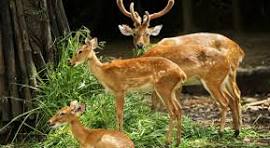
- 1. Activities
Wildlife observation: Suitable for observation and photography of wildlife in the natural habitats. - Nature Walks: Explore the trails amidst the greenery and enjoy the fresh mountain air.
- Picnics: The park offers enough space for families and groups to relax and enjoy a picnic.
2. Best Time to Visit: Open throughout the year but seems best for spotting wildlife early morning and evening.
Winters (November to February) offer pleasant weather, while monsoons add a lush, green vibe.
3. Timings and Entry: The park is open all the way to late afternoon morning.
Entry fees are very low, and the entry fee is channeled towards park maintenance.
Amenities and Facilities
Parking area and toilet facilities are present.
Food stalls and kiosks sell snacks and refreshments.
Benches and shaded spots to rest while visiting.
Tips for Visitors
Take along some water and snacks, especially when taking children along.
Comfortable walking shoes and weather appropriate attire.
You respect the wildlife through avoiding loud noises and refraining from feeding animals.
Why Visit Malsi Deer Park?
The harmonious blend of wildlife, nature, and recreation offered by Malsi Deer Park makes it a great spot for a fun family outing or for nature enthusiasts looking for solitude, as well as for any wildlife photographer. Being close to Dehradun and Mussoorie, this is an excellent stop on any travel itinerary.
4. Outdoor Adventures
Trekking and hiking trails in the surrounding hills
The foothills of the Himalayas home one of the most beautiful trekking and hiking trails in northern India. Dehradun provides an entrance into these trails that are easy, moderate, and challenging with magnificent views, beautiful greenery, and nature contact.
Popular Trekking and Hiking Trails
- 1. Robber’s Cave to Anarwala Village
Difficulty: Easy
Distance: ~4 kilometers (round trip)
Highlights:It is a short trek starting from Robber’s Cave (Guchhupani), crossing streams, forested areas, and rural landscapes.
Suitable for a beginner and families.
Best Time: Year-round, but monsoons enhance the lush surroundings.
2. Lambi Dehar Mines to Mussoorie Road Trail
Difficulty: Moderate
Distance: ~7 kilometers (one way)
Highlights: It passes through dense forests with panoramic views of the Shivalik ranges.
Famous for its haunting legends, which lend an air of mystery to the trip.
Best Time: October to March for cool and pleasant weather.
3. George Everest House Trek
Difficulty: Easy to Moderate
Distance: ~6 kilometers (round trip)
Highlights: It starts near Mussoorie and leads to the historical George Everest House.
The Doon Valley and the snow-clad Himalayan peaks can be seen.
Best Time: Sunrise or sunset for dramatic views and photography.
4. Nag Tibba Trek
Difficulty: Moderate to Challenging
Distance: ~15 kilometers (round trip)
Highlights:It is the highest at 3,022 meters with one known as “Serpent’s Peak.
Dense forests, alpine meadows, and 360-degree views of the Himalayas from the summit.
Perfect for that overnight trekking or weekend escapade.
Best time: Winter, with snow; or spring, with rhododendron in bloom.
5. Maldevta to Lachhiwala Nature Trail
Difficulty: Easy
Distance: ~5 kilometers (one way)
Highlights:A peaceful walk through small brooks, woodland patches, and open fields.
Good for bird watching and picnic.
Best time: Early morning or late afternoon in spring and autumn.
6. Chakrata Tiger Falls Trail
Difficulty: Moderate
Distance: ~6 kilometers (round trip)
Highlights: A scenic walk to the impressive Tiger Falls at Chakrata.
Walk through thick forests and enjoy the sound of cascading water.
Best Time: Monsoon for the full flow of the waterfall or winter for clear skies.
Essential Tips for Trekkers
Preparation: Comfortable trekking shoes and clothing suitable for the weather.
Sufficient water, snacks, and a basic first-aid kit.
Use trekking poles to provide stability on uneven trails.
Respect Nature: Do not litter; keep the trails clean.
Do not disturb the wildlife or pluck plants.
Guides and Permits: For lesser marked trails, use local guides to ensure safety and knowledge of the region.
Find out if some trails require a permit.
Day trips to Mussoorie, Haridwar, or Rishikesh
Strategically located, Dehradun is an ideal base for day trips to some of the most iconic destinations in northern India. Mussoorie, Haridwar, and Rishikesh are all easily accessible, offering diverse experiences-from hill station charm to spiritual serenity and adventure.
1. Mussoorie: The Queen of Hills
Distance and Travel Time
Distance: ~35 kilometers
Travel Time: ~1.5 hours by road
Highlights of Mussoorie
1. Mall Road: Stroll along the busy promenade, lined by shops, restaurants, and colonial-style architecture.
2. Kempty Falls: A popular picnic spot and a refreshing dip in cascading waters.
3. Gun Hill: Take a cable car ride to see panoramic views of the Doon Valley and the Himalayas.
4. Cloud’s End: A peaceful sanctuary with breathtaking vistas and peaceful walking trails.
5. George Everest House: Explore this ancient site and discover stunning views.
Recommended Itinerary
Leave Dehradun in the morning.
Visit Mall Road and Gun Hill.
Have lunch at a local café.
Spend the afternoon at Kempty Falls and George Everest House.
Return to Dehradun by evening.
Exploring Rajaji National Park for wildlife
For nature and wildlife lovers living in Dehradun, Rajaji National Park is something of heaven on earth. It stretches over three districts: Dehradun, Haridwar, and Pauri Garhwal, and lies in the Shivalik range of the Himalayas. Its richest diversified ecosystem, high biodiversity, and extremely beautiful landscapes make it one of the most significant places to be visited for any thrilling experience with wildlife
Location and Accessibility
Distance from Dehradun: ~20 kilometers
Nearest Entry Points:
Chilla Gate (near Haridwar)
Motichur Gate (near Rishikesh)
Ranipur Gate (near Haridwar)
- Travel Time: ~40 minutes to 1 hour from Dehradun
Highlights of Rajaji National Park
- Diverse Wildlife: Home to over 50 species of mammals, including:
Elephants: One of the largest populations of wild Asian elephants in India.
Tigers and Leopards: Elusive predators that roam the dense forests.
Sloth Bears, Wild Boars, and Goral (Mountain Goats): Frequently spotted during safaris.
Birdwatching Haven:Over 300 species of birds, including: - Hornbills, Kingfishers, and Eagles: Perfect for birdwatching enthusiasts.
Seasonal migratory birds in the winter months. - Scenic Landscape:
A mix of riverine forests, grasslands, and Shivalik hills.
Ganga and Song Rivers flow through the park, enhancing its beauty. - Safari Experience: Open jeep safaris provide an excellent way to explore the park’s wilderness.
Morning and evening safari slots are available, each offering unique sightings.
Visitor Information
Best Time to Visit:
November to June: Ideal for safaris, as the park is closed during monsoons (July–October).
Winters (November–February): Cooler weather and higher chances of spotting wildlife.
Safari Details:
Timings:
Morning: 6:00 AM – 9:30 AM Evening: 3:00 PM – 6:00 PM
Duration: 2.5 to 3 hours
Booking: Safaris can be booked online or at the park’s entry gates.
Entry Fees: For Indian and foreign tourists, it varies with extra charges for vehicles and cameras.
Things to Do
Wildlife Safari:
Enjoy wildness and see the animals in their natural habitat.
A seasoned guide accompanies each safari for security and information purposes.
Nature Walks:
Guided walks through designated trails allow a closer connection to the park’s flora and fauna.
Photography:
A varied landscape and wide range of wildlife have made the park a photographer’s paradise.
Picnicking by the River:
Relax at designated spots near the Ganga or Song River.
Tips for Visitors
What to Wear:
Neutral-colored clothing for camouflage.
Comfortable walking shoes.
What to Carry
Water bottles, light snacks, sunscreen, and binoculars.
A good camera for capturing wildlife and landscapes.
3. Follow Guidelines:
Do not litter and feed the animals.
Maintain silence and do not make sudden movements during the safari.
4. Safety First:
Always stay in designated areas and follow the instructions of the guides or rangers.
5. Educational and Research Institutions
Indian Military Academy (IMA): Brief overview and importance.
One of the top officer training institutes for officers from the Indian Army, Indian Military Academy, was set up in 1932 and has had the distinction of being home to some of the most finest military minds serving their country with distinction. It sits sprawling in front of the backdrop of Shivalik hills symbolizing discipline, dedication, and love for one’s nation.
Welham and Doon Schools: Renowned educational institutions.
Key Highlights
1. Training Excellence: The academy offers comprehensive physical, mental, and leadership training for its cadets.
Highlights core teaching values: duty, honor, and loyalty.
2. Infrastructure: Equipped with state-of-the-art facilities, such as training grounds, shooting ranges, and classrooms.
The central building of Chetwode Hall, which houses the administrative offices and the museum, was named after Field Marshal Sir Philip Chetwode.
3. Graduates: It is a proud heritage that officers graduating from IMA go on to excel in crucial roles at the national and international level.
Importance
National Defense: Provides an opportunity to strengthen India’s defense capabilities by preparing future Indian Army leaders.
Historical Importance: The academy is a tradition symbolizing India’s martial heritage.
Civic Pride: Its presence in Dehradun intensifies the city as a center of excellence for education and training.
Welham and Doon Schools: Renowned educational institutions
Welham Girls’ and Boys’ Schools
- 1. Overview:
Welham Girls’ School (founded in 1957) and Welham Boys’ School (founded in 1937) are two of the most elite boarding schools in India.
It caters to well-rounded development that includes academics, sports, arts, and building character.
2. Legacy:
Known for producing leaders, artists, and professionals who excel in a variety of fields.
Some of the distinguished personalities who are alumni include Indira Nooyi, former CEO of PepsiCo, and many more.
3. Educational Philosophy:
Both schools value and emphasize discipline, humility, and a sense of community.
The Doon School
1. Overview:
The Doon School was found in 1935 and was popularly nicknamed the “Eton of India.”
It is a boys-only boarding school that tries to develop the all-around individual in academics, leadership, and extracurricular activities.
2. Global Recognition:
Known for its high standards of education and emphasis on developing global citizens. - The alumni are former Indian Prime Ministers, industrialists, authors, and diplomats.
3. Unique Approach:
It focuses on inquiry-based learning, leadership development, and fostering a spirit of service.
Importance of These Institutions
Academic Merits: Schools have devised benchmarks in Indian education in which the traditional values are amalgamated with modern pedagogy. - Leadership Development: It is known to shape leaders that are significantly contributed to India and the world.
- Reputation: Their presence enhances Dehradun’s status as a hub for quality education, attracting students from all over the world.
6. Local Cuisine and Food Experiences
Famous dishes: Aloo ke Gutke, Kandalee ka Saag, Bal Mithai
Dehradun’s local cuisines reflect the rich, vibrant traditions of Uttarakhand and give rise to diverse flavors enjoyed by both local folks and visitors. Here are some must-try dishes from the region.
2. Kandalee ka Saag
Description: A healthy green leafy dish prepared from stinging nettle leaves (kandalee) and cooked with local spices, garlic, and ghee.
Health Benefits: Rich in iron, calcium, and vitamins, making it both tasty and wholesome.
Unique Aspect: Use of nettle leaves makes it to be a kind of rare, interesting delicacy, native of the region.
3. Bal Mithai
Description: Bal Mithai is one of the most popular sweet dishes of Uttarakhand, where caramelized sugar balls are coated over roasted khoya (reduced milk solids).
Texture and Taste: It’s chewy, with a nutty sweetness; it’s perfect as a dessert treat.
Where to Find: It is originally found in Almora but widely available in Dehradun and Mussoori.
Popular Local Eateries and Cafés in Dehradun
Dehradun offers a blend of traditional eateries and modern cafés, catering to diverse tastes. Here are some top recommendations:
1. Kalsang Friends Corner
Cuisine: Tibetan, Chinese, and Thai
Highlights:
Famous for momos, thukpa, and chili chicken.
Cozy ambiance with authentic flavors.
Location: Rajpur Road
2. The Orchard
Location: Near Rajpur
Cuisine: Pan-Asian
Highlights:
Scenic outdoor seating with a view of the hills.
Tibetan hot pot and pad Thai must be tried.
3. Ellora’s Melting Moments
Location: Near Ashley Hall
Cuisine: Bakery and Snacks
Highlights:
Pastries, rusks, and savory snacks are popular.
A favorite local haunt for quick bites and baked goods.
4. Café De Piccolo
Location: Rajpur Road
Cuisine: Italian and Continental
Highlights:
Quaint wooden interiors with a cozy feel.
Must-try dishes: Thin-crust pizza and creamy pastas.
5. Buffet Snacks Shop
Cuisine: Street Food
Highlights:
Chaat, golgappas, and aloo tikki are famous.
A busy place for authentic street food.
Location: Chakrata Road
6. Y Café and Restaurant
Cuisine: Continental and Indian
Highlights:
Vintage theme café with laid-back ambiance.
Club sandwich and coffee must-try.
Location: Near Rajpur
7. Shopping in Dehradun
Dehradun is a shoppers’ paradise-its markets so full of local handicrafts and souvenirs and such treasures that it forms a heaven indeed. Two of the other most popular haunts are, of course Paltan Bazaar and Tibetan Market, respectively.
- 1. Paltan Bazaar: Best for souvenirs and local crafts
Paltan Bazaar is one of the oldest and most crowded markets in Dehradun, located near the Clock Tower in the heart of the city. It’s a hub for all souvenirs, local crafts, and daily essentials.
What to Buy
1. Souvenirs:
Handicrafts, keychains, and decorative pieces.
Those depicting the Garhwali and Kumaoni culture.
2. Local Crafts:
Wooden handicraft items and local jewelry.
3. Textiles:
Vibrant and inexpensive kurtis, shawls, and scarves.
4. Food Specialties:
Spices, pickles, and local snacks like bal mithai and singori.
Shopping Tips
Bargain: Negotiation is widely practiced, so do not hesitate to bargain.
Explore Side Lanes: Treasures are found in the quieter side lanes.
Visit Early: To avoid the rush and explore comfortably.
2. Tibetan Market: Handicrafts and woolen items
Overview
Located near Parade Ground, the Tibetan Market is a place that sells both traditional Tibetan and modern items. It is famous for its lively atmosphere and excellent woolen collection.
What to Buy
- Handicrafts:
Beautifully carved Buddhist prayer wheels, singing bowls, and wall hangings.
Tibetan motif jewelry.
2. Woolen Items:
Good quality shawls, stoles, sweaters, and gloves.
Good for winter shopping.
3. Accessories:
Bags, belts, and quirky stuff like phone cases
4. Home Décor:
Carpet, rugs, and colorful tapestries.
Shopping Tips
Authenticity Check: The products must be authentic, especially woolen products.
Cash Ready: Many vendors prefer cash payments over cards.
Take Your Time: The market is small but full of treasures, so take your time.
Seasonal Overview of Dehradun: Best Time to Visit
Dehradun is very unique because of its four seasons, and every season gives it a different feel. From the snow to the nice time and green sceneries, this Himalayan foothill city offers all types of travel experiences.
1. Winter (October to February): Snow Enthusiasts’ Delight
Weather
Temperature Range: 5°C to 20°C
Experience: Crisp and chilly days with colder nights.
1. Nearby Snow Destinations: While Dehradun does not receive snowfall, the places around it like Mussoorie and Dhanaulti become winter wonderlands.
2. Festive Atmosphere: Enjoy Christmas and New Year in the local markets and cafes.
3. Adventure Activities: Best for trekking and hiking while it is relatively cool.
Travel Tips
Pack warm clothes, such as jackets, gloves, and thermals.
Early mornings and late evenings can be particularly cold, so plan your activities accordingly.
Summer (March to June): A Pleasant Escape
Weather
Temperature Range: 17°C to 35°C
Experience: Warm days with cooler evenings bring relief from the plains’ heat.
Why Visit?
1. Comfortable Climate: Ideal for sightseeing, outdoor activities, and nature trails.
2. Lush Greenery: The hills and valleys are at their most vibrant.
3. Popular Attractions: Refreshment can be sought at Robber’s Cave, Sahastradhara, and Malsi Deer Park.
Travel Tips
Light loose weaved cotton clothing is preferable, but do take a shawl or light jacket for evenings.
Sunscreen and sunglasses are day trip must-haves.
3. Monsoon (July to September): Lush Greenery and Tranquility
Weather
Temperature Range: 20°C to 30°C
Experience: Frequent rains that refresh the area, giving it a peaceful ambiance.
Why Visit?
1. Nature’s Splendor: It has turned the location into a haven for nature lovers and photographers because of the lush greenery around.
2. Peaceful Getaway: Fewer tourists mean quieter attractions and uncrowded spaces.
3. River Views: Streams and waterfalls like Sahastradhara are flowing in full, beautifying the surroundings.
Travel Tips
Carry waterproof clothing and sturdy shoes for rain-soaked paths.
Exercise special care when visiting landslide zones in your region’s hilly areas.
9. How to Get There and Around
Connectivity to Dehradun: Getting There and Around
Dehradun has good connectivity to all major Indian cities through the air, railway, and road network. Within the city, a range of local transport services makes it an easy and hassle-free place to explore.
1. By Air: Jolly Grant Airport
Location: ~30 kilometers from the city center.
Connectivity:
Direct flights to the major cities like Delhi, Mumbai, Bangalore, and Lucknow.
Daily flights operated by domestic airlines ensure smooth travel.
Airport Facilities:
Comfortable lounges, eateries, and transport options for onward journeys.
Transport from Airport:
Taxis: Available outside the airport.
Prepaid Services: Fixed-rate prepaid taxi counters are convenient.
2. By Rail
Dehradun Railway Station:
Located at the core heart of the city, the station links Dehradun to the major cities.
Good network with express and superfast trains like:
Dehradun Shatabdi Express (Delhi to Dehradun)
Nanda Devi Express (New Delhi to Dehradun)
Mussoorie Express (Delhi to Dehradun, overnight option)
Waiting rooms, food, and transport facilities are also available.
3. By Road
Highway Connectivity:
Dehradun is accessible by good roads to Delhi (240 km), Haridwar (54 km), and Mussoorie (33 km).
The NH 72 and NH 307 make road travel smooth and picturesque.
Bus Services:
ISBT Dehradun: Big bus station which has buses very frequently to Delhi, Haridwar, Rishikesh and other cities.
Options include:
Volvo and AC Buses: Comfortable and faster.
State-Run Buses: Economical choices for budget travelers.
Private Cabs: Available for intercity and local places such as Mussoorie or Haridwar.
Getting Around Dehradun: Local Transportation Options
1. Auto-Rickshaws
Widely available and inexpensive for short distances.
No meters; fares are typically negotiated in advance.
2. Cabs and Ride-Sharing Services
App-Based Cabs: Ola and Uber are widely present in Dehradun.
Local Taxi Services: Available for sightseeing and intercity travel.
3. Buses
City Buses: Operated by Uttarakhand Transport Corporation, connecting key areas within the city.
Private Mini Buses: Economical but may be crowded during peak hours.
Best suited for budget-conscious travelers.
4. Cycle Rickshaws
A slower option that is more environmentally friendly, suitable for short distances within the city.
5. Two-Wheeler Rentals
Very popular for independent exploration of the city and area.
Rental service options for scooters and bicycles are available with flexible hourly or daily rates.
Travel Tips
- Plan Ahead: Reserve airline and rail tickets ahead of peak seasons.
- Transport Apps: Use apps like Google Maps or ride-hailing apps for convenience and accurate fare estimates.
- Safety First: Only use licensed transport services and avoid using unlicensed ones.
10. Accommodation Options
Range of options: Budget stays to luxury resorts.
Where to Stay in Dehradun: From Budget to Luxury
Dehradun has a lot of accommodation options, from budget to luxury, catering to every type of traveler. Be it a solo backpacker, a family on vacation, or a luxury seeker, there is something for everyone.
1. Budget Stays: Affordable Comfort
Ideal For:
Backpackers, solo travelers, and budget travelers.
Options:
Hostels:
Zostel Dehradun (Rajpur Road): It is an affordable dormitory-type accommodation with a young crowd and good social experiences.
GoSTOPS Dehradun: This is a lively accommodation with shared and private rooms for budget travelers.
Guesthouses and Lodges:
Hotel Siddharth Residency: Conveniently located with basic amenities at pocket-friendly rates.
Himalayan Guest House: Simple and clean rooms near major attractions.
Starting Price: ₹500 to ₹1500 per night.
2. Mid-Range Hotels: Value for Money
Ideal For:
Families, small groups, and business travelers.
Options:
Boutique Hotels:
Hotel Madhuban: With its pleasant ambiance and good service, this is situated on Rajpur Road.
Treebo Trend Grand Legacy Elite: Clean, well-maintained rooms with modern amenities.
3-Star Hotels:
Hotel Pacific Dehradun: Provides spacious rooms and easy access to major landmarks.
Four Points by Sheraton: Comfortable and reliable for both leisure and business stays.
Starting Price: ₹2000 to ₹4000 per night.
3. Luxury Resorts and Premium Hotels
Ideal For:
Couples, honeymooners, and travelers seeking indulgence.
Options:
Luxury Resorts:
Jaypee Residency Manor, Mussoorie Road: Large resort that is set within panoramic views, premium amenities and serenity right for the correct get away.
Shaheen Bagh Boutique Resort: A very nice property amidst the green, which is actually a peaceful haven.
High-class hotels.
Hyatt Regency Dehradun: Offers international standard facilities like a spa, rooftop dining, and super luxurious rooms.
Lemon Tree Hotel is an upscale counterpart to those that wish for comfort together with proximity to the city centre.
Starting Price: ₹5000 to ₹15,000 per night.
Recommendations Based on Traveler Preferences
For Nature Lovers
Shaheen Bagh Boutique Resort: This resort has lush green surroundings and is for those who desire a serene yet scenic landscape.
Hill View Apartments: Offers affordable accommodations along with an outstanding view of the hills.
For Families
Hotel Pacific Dehradun: spacious rooms and friendly family services.
Hyatt Regency Dehradun: This provides a kid-friendly environment along with recreational facilities.
For Backpackers and Solo Travelers
Zostel Dehradun: this is a suitable place to make friends and spend time while budgeting.
GoSTOPS Dehradun: Colorful, affordable option with lively community.
For Couples
Jaypee Residency Manor: For a romantic escapade with lavish amenities.
Shaheen Bagh: For the quietest, most intimate retreat.
Tips for Choosing Accommodation
Location Matters: Stays close to Rajpur Road for convenience. It provides cafes and markets access.
Outskirts or hill-facing properties can be opted for a serene ambiance
Book Early: Book your stay in advance during peak seasons, which include summer and winter holidays.
Check Amenities: Ensure the property offers essentials like Wi-Fi, parking, and in-house dining.
11. Travel Tips
Packing essentials for different seasons.
Summer (March to June):
Light cotton clothes, sunglasses, sunscreen, and a hat.
Comfortable walking shoes to play outside.
Light jacket for evenings in higher altitude.
Monsoon (July to September):
Waterproof jackets, umbrella, and rugged, slip-proof footwear.
Repellent and quick-drying clothes.
Electronic devices with a waterproof bag or cover.
Winter (October to February):
Heavy woolens, thermals, and insulated jackets.
Scarves, gloves, and woolen caps for chilly morning and evening.
Comfortable footwear with good grip for trekking or snow visit.
Safety precautions for outdoor activities.
Trekking and Hiking: Travellers should use marked trails and walk in groups or with a guide.
Carry water, energy snacks, and a basic first-aid kit.
Avoid trekking during heavy rains to avoid accidents.
Water Activities (Sahastradhara, Robber’s Cave): Caution is advised where slippery rocks or strong water currents are present.
Wear suitable footwear to prevent injuries.
Wildlife Exploration (Rajaji National Park): Comply with the rules of the park and stay at a safe distance from animals.
Do not litter and respect the natural habitat.
Respect for local customs and environment.
Cultural Sensitivity: Dress modestly, especially in religious places such as Tapkeshwar Temple or Mindrolling Monastery.
Remove shoes when entering temples or monasteries.
Interaction with Locals: Be respectful and greet with a smile or a “Namaste.”
Ask permission to take pictures of locals or their property.
Environmental Respect: Don’t litter; carry reusable bags and bottles.
Follow the concept of “Leave No Trace” while trekking or having picnics.
Support eco-friendly practices and avoid disturbing wildlife.
Conclusion
Dehradun is more than the gateway to the Himalayas. In fact, the city has enough history, nature, and vibrant culture that visitors will have lots to enjoy—be it trekking in hills, exploring ancient temples and serene monasteries or savoring local delicacies and adventure-filled activities.
Whether you are looking for a peaceful retreat in nature, an educational journey through colonial and cultural landmarks, or a taste of the warm hospitality offered in Uttarakhand, Dehradun is the place. Respect the environment, cherish local traditions, and let the city’s timeless charm leave you with unforgettable memories.


